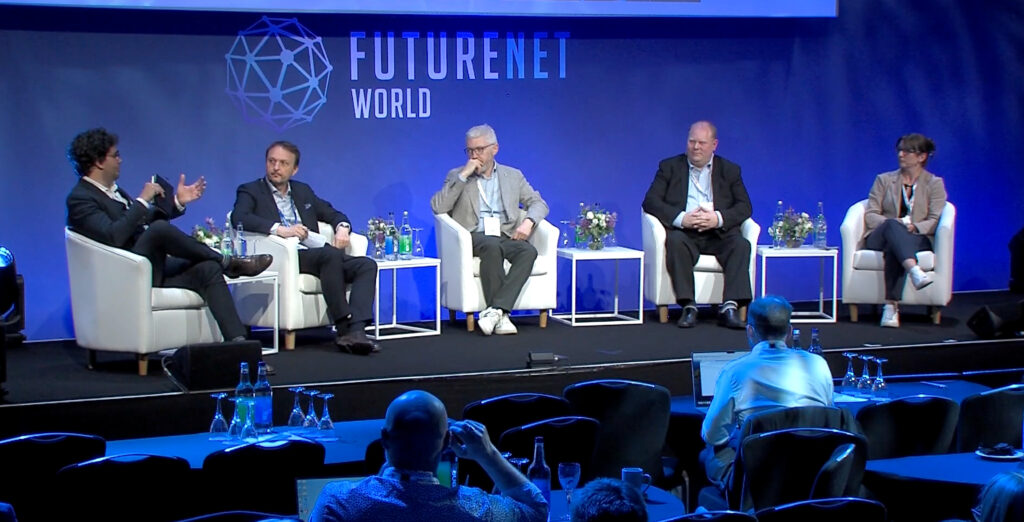Private 5G doesn’t need (!) AI – but telcos like BT, KPN and Telenor say it’s the difference between ticking over and taking off. Scale it up, and AI goes from ‘nice-to-have’ to non-negotiable.
In sum – what to know:
Casual to causal – private 5G doesn’t need AI to sell or to function, but AI is key for private 5G to scale, and it is shaping its future in other ways besides, known or not.
Public first, private fast – operators see AI landing in public networks first, but private 5G offers a nimble launchpad for innovation, and higher-grade 5G is going into enterprises.
Two-way street – telcos have struggled to understand enterprises, and enterprises have struggled to understand telcos; AI might help, and also offer neat bundling opportunities.
Raise your hand if you think private 5G needs AI. This was the request to the audience at FutureNet World a couple of weeks back, and the panel never quite got over the response. Not because only three hands (in a graveyard shift) went up, but because the question was two-sided, at least – and mobile operators BT, KPN, and Telenor argued the toss. Does it need AI? Of course it doesn’t need AI – if you just want to automate industrial equipment, and if AI is not more than pattern-matching ML to drive well-telegraphed operational efficiencies. Private 5G is being sold in decent numbers for just such ends. But AI is something more – everyone says. So it makes private 5G better, the panel said.
A note: this is a late writeup from FutureNet World, covered variously, from a session RCR missed on the day, but caught on-demand – after it was flagged on social media by Pablo Tomasi, principal analyst for private networks at Omdia, who steered the panel through its paces. It was Tomasi’s first question, which, between stuff about security (“super-important”) and sovereignty (what operators do well), was returned to over and again, and which captured the mood and produced responses that are perhaps worth memorialising. Except, it was a question that was also quickly rephrased, to set the scene and gauge progress: is private 5G a solution without a problem?
It was, before – responded Tommy Björkberg, vice president of network and cloud at KPN. “Private networks have been around for a long time, but… [yes] private 5G started as a solution without a problem.” Björkberg is a veteran of Ericsson, as well as ZTE, and he recalled their initial approach to selling it. “It was all about ultra low latency and high bandwidth and security. We approached the market in the wrong way – talking with enterprises about how to deliver an HLR (Home Location Register] and a core network in a box, together with a radio, is not the right conversation. It wasn’t until we started talking about how it can reduce faults in factories… that we started to get traction.”

Today, private 5G is in a “good spot”, he said. “There’s more to be done, but there are really interesting use cases that deliver value for enterprises.” But it is a two-way street, noted Cathal Kennedy, acting group chief technology officer at Telenor. He reflected: “[Enterprises] have built very professional [SIM-buying] organizations. But are they competent buyers [of private 5G]? It is taking more time than [we] expected for that knowledge and competence on the customer side – to understand what these capabilities are.” It is a curious argument, not often heard; the sales side more often dons sackcloth and ashes, and tells how it has changed its ways – to listen, collaborate, solve etc.
But Kennedy also agreed. “[It] is in a good spot now,” he said. “We see a lot of [demand] from hospitals [for example], which get that this is not a Wi-Fi network; that it is something much more advanced. Once you get the confident buyer, then you’re in a much better position.” It took for Mavenir, the only vendor on the panel, to get down to brass tacks, and address this kind of decoupled symbiosis between 5G and AI in enterprise venues. “I agree with both [sides],” said Virtyt Koshi, senior vice president and general manager for the firm in the EMEA region, picking up on the earlier show-of-hands. “You don’t need AI – if you want to stay where you are.”
Which is also a way of saying exactly the opposite: that you need AI to thrive, and maybe just to survive. “[If] there is no competition, then why bother, right? Except for intellectual satisfaction, maybe. But we live in a competitive [world]; everybody’s looking for opportunities… If you’re an operator, [selling] minutes and texts, maybe [deploying] 5G for gimmicks, then maybe you don’t need [AI]. But soon, even if it is not overnight, there [will be] a slow decline. We’ve seen it with companies that used to be massive 20 years ago,” he said. Which is about telcos using AI for telco gains; it does not actually make the case for both – for domain AI plus private 5G.
And so Koshi went on, with an aside as well about all the old specialist sectors (“oil companies, wind farms, cities, defense, ministries, emergency services”) and new specialist partners (“Anterix, Boldyn, Freshwave”) that Mavenir has worked with to deploy private 5G, leading to some kind of private AI. He said: “There are opportunities left, right, and center. We work with two mining companies in Australia who have deployed autonomous trucks. No one drives these trucks, or maintains them – and they work around the clock. [They are part of a] mission critical system, and a small failure, causing an outage of 10 minutes or half an hour, [costs] hundreds-of-thousands and millions in losses.”
Is that about 5G-plus-AI? Not necessarily, he acknowledged; but it is implicit in the telco example, which translates to any vertical where the enterprises want to get ahead. He said later in the session: “The risk is not investing in future technologies – like AI. Given that what is going on in the [telecoms] industry – towards cloud-native, open, programmable networks – the platform for innovation [is being set] in many directions, including the use of AI.” So, there you go: one begets the other, whichever way around you want to play it. Most of the discussion was about AI in networks. There is (RCR reckons) a debate about where it pitches up first, and fastest: in public or private networks.
Björkberg at KPN said it will happen in big public macro networks first. He responded: “Do you need AI for private networks? No. These things are not necessarily a [necessary] marriage… But private networks will leverage AI, just like public networks will, to drive efficiency and automation. Probably, we will do that in our public networks first because that’s the biggest win for us as national operators. But the flipside is we are building private networks to support industries and enterprises… [and] they, just like us, are looking to leverage AI.” Of course, this is a carrier’s perspective, and vendors and integrators are pushing higher-grade 5G SA on smaller footprints into enterprises first.
So there is a good argument that more-manageable AI pyrotechnics will be let loose in ‘programmable’ private 5G networks first. Laura Carney, director of network cloud and cloud services at BT Group, reflected: “It’s not just private networks, it’s any network. But yes, AI really enhances the benefits of private networks that we see already.” She listed its value for threat detection, load balancing, resource optimization (“geographically or locally”), and all the futuristic stuff about self-healing. Kennedy at Telenor talked about the role of AI to help provision private 5G networks (as well as public 5G slices) at scale.
“If you only have five or 10 private networks, then the case can be made that you don’t really need AI,” he said – again, calling tails, and answering the question from one angle. “But if we will have hundreds of thousands of private networks, then it is a different discussion. If the network is the product… you will need AI to [deploy, and scale, and manage].” Björkberg called heads (or three pips, or five, on a d6 D&D dice), and talked about how it is only a skip-and-a-jump for telcos selling private 5G networks to also host or handle domain-specific AI. “You’re looking beyond [just] private networks, to support industry specific models,” he said.
“[Because] nobody’s going to run a trillion parameter LLM, which has been taught everything on the internet, inside an enterprise. If I want a visual inspection tool for a manufacturing plant… then I want something that is trained on that… [So] we are going to see an evolution from conversational models to [contextual industry] models, where models understand the [enterprise] world around them… And private networks will support the delivery of those models in a secure low-latency way. But you don’t need AI for private networks, or vice versa.” Maybe we were getting somewhere. Telenor is offering GPUs as-a-service, said Kennedy, and its engagements have expanded.
He explained: “Because of sovereign needs, we need to have AI capabilities in-country. We have built this GPU as-a-service capability. And we have managed to get customers. What is interesting is the conversation [with enterprises]. We have a forklift truck customer with private networks, [which also needs] private networks for their customers. So [the] mobilization of new technology will drive new needs… As these [AI] models develop, and as new needs come from customers, [new] demand [for 5G and AI will be created] because they will need guarantees about network performance that only we can provide.” So yeah: open question, open answer – and interesting to consider.
The panel ran through some of the challenges, as well – with AI in the enterprise domain, where private 5G networks are deployed. “Cost is definitely a thing,” said Carney. Cost is the only thing, probably – if cost/value is predicated on use-case returns. It is the same with private 5G (and IoT, and whatever else). Carney explained: “It’s an expensive upfront investment potentially. We don’t really understand exactly what that looks like yet. So we’ve got to try and get around that and understand… the return on investment that we’ll get.” Whether she is talking about AI in public networks or private networks, or about private networks in support of industrial AI applications – the logic holds.
The panel listed some other obstacles, as well. AI data quality and AI model drift were raised as headaches by Kennedy and Björkberg (“things that keep me awake at night”) respectively. But cost is king, and everything about the takeup of technology comes out of it – and so we will leave it there.

